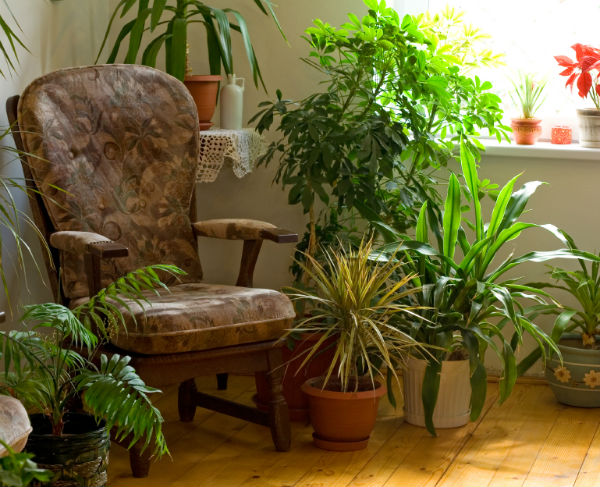The level of air pollution generated by
volatile organic compounds (VOCs) such as carcinogenic
benzene,
formaldehyde,
ammonia and methylene chloride can be up to
10 times higher within the four walls of your home than what happens to be floating around right outside your window.
With more than
80,000+ manmade chemicals releasing toxic gaseous chemicals, we’d all be wise to reassess the materials that we feather our nests with. Unfortunately, VOCs are commonly used in the manufacturing of conventional furniture and household décor items (anything that is varnished or made with fiber or particle board, for example), so becoming a keener, greener consumer requires exercising some, if not all, of the following tips:
Create ventilation
Is your home incredibly energy efficient? While you deserve a high five for saving power, the fact that the cracks and crevices in your household are well sealed means that there is little to no airflow. In other words, VOCs are trapped where you don’t want them to be: in your airspace.
Breathe a lot easier by installing a ceiling fan in your living room to draw pollutants out of the nearest open window(s) — and keep the fresh air flowing whenever the weather allows by habitually opening your windows.
Kick carpet to the curb
Cushy and attractive though they may be, modern-day carpeting options are generally made of woven, chemically laden
polypropylene, nylon or polyester fibers derived specifically from petroleum.
The carpet pad beneath is also cause for concern (as is the glue used to tack it down to the underlying foundation) because
both are particularly prominent sources of VOCs. If removing the carpet in your household is fiscally impossible, consider
investing in a highly rated HEPA vacuum cleaner.
Green up your household environment with potted plants
They look attractive and remind us of just how centering Mother Nature can be, but potted greenery such as heart leaf philodendrons, gerbera daisies, anthuriums, spider plants, peace lilies, epiphytic bromeliads, palms, rubber plants, chrysanthemums, golden pothos and ferns
are also capable of filtering 87% of common airborne toxins out of our indoor environment every 24 hours and reducing dust particles by a not-too-shabby 20%, as well! Seems like a trip to your local home improvement center or nursery is just what the doctor ordered!
Apply VOC-free paint to your walls
Long after the eggshell white has been rolled or brushed onto the walls of your home, VOCs like acetaldehyde and formaldehyde are still released into the air that your breathe, even if you can’t actually detect that all-too-familiar unpleasant chemically scent. Experts highly recommend “sealing” preexisting paint coats with a primer that encapsulates VOCs (
Zinsser B-I-N Primer is a good one to consider) — with the windows wide open! — and then following with a VOC-free paint, which technically contains 5 grams or less of VOCs per liter. Top brands include
Ecos Organic Paints and
Earth Safe Finishes.
Allow new furniture/décor items to off-gas outside
Not everyone is blessed with an unlimited expense account, so when green, VOC-free household furnishings are fiscally impossible, make a point of allowing any new, conventionally manufactured items to off-gas outside your home for at least 24 hours (frankly, the longer the better).
This tip applies to area rugs, bookshelves, entertainment systems, couches and pretty much any item that releases a chemical scent. If you do just one thing, try to eliminate your exposure to carcinogenic, formaldehyde-emitting wood-paneled furniture pieces all together, no matter how temptingly affordable they may be.
Eliminate all conventional scent-releasing products
You may have a soft spot for plug-in/gel/spray air fresheners and candles, but that irresistible sugar cookie scent wafting through your house is likely created with
phthalates, the same chemical compound that triggers
hormonal complications, reproductive issues and birth defects as well as asthma and allergic reactions.
Scented products are also commonly
laden with other harmful chemicals, too, such as
toluene, styrene, glycol ethers, carbolic acid, chlorbenzene and paradichchlorobenzene, all of which pose serious health risks to children and adults alike. Blech!
Add an air purifier
You already have the houseplants, which is good, but your VOC-torching abilities can rise to “great” status simply by coughing up the cash for a machine
designed specifically to filter assorted pollutants from your airspace. While the cost varies significantly, the most important features to focus on among available models include those that generate no ozone emissions and are equipped with more than one micro-filter for optimum filtration capabilities.
Place small ramekins throughout your home filled with naturally deodorizing ingredients such as coffee beans (or recycled coffee grounds), baking soda, white vinegar, lemon juice, assorted fresh citrus peels and/or essential oils. You might even take it one step further by
cooking up your own stovetop potpourri recipe or simmering white vinegar in a pot for at least half-an-hour for a really effective way to temper stale odors. Ahhh, now
that’s the smell of sweet VOC-free success.


